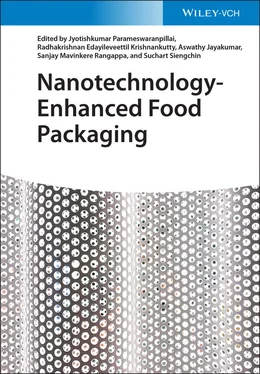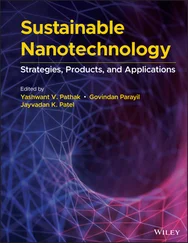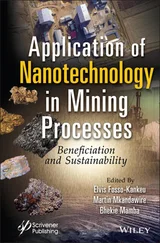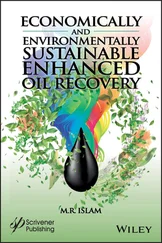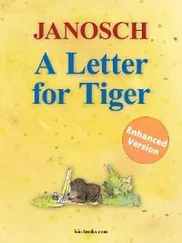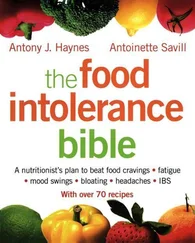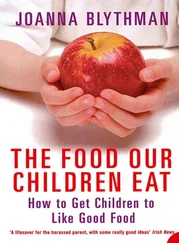Nanotechnology-Enhanced Food Packaging
Здесь есть возможность читать онлайн «Nanotechnology-Enhanced Food Packaging» — ознакомительный отрывок электронной книги совершенно бесплатно, а после прочтения отрывка купить полную версию. В некоторых случаях можно слушать аудио, скачать через торрент в формате fb2 и присутствует краткое содержание. Жанр: unrecognised, на английском языке. Описание произведения, (предисловие) а так же отзывы посетителей доступны на портале библиотеки ЛибКат.
- Название:Nanotechnology-Enhanced Food Packaging
- Автор:
- Жанр:
- Год:неизвестен
- ISBN:нет данных
- Рейтинг книги:3 / 5. Голосов: 1
-
Избранное:Добавить в избранное
- Отзывы:
-
Ваша оценка:
- 60
- 1
- 2
- 3
- 4
- 5
Nanotechnology-Enhanced Food Packaging: краткое содержание, описание и аннотация
Предлагаем к чтению аннотацию, описание, краткое содержание или предисловие (зависит от того, что написал сам автор книги «Nanotechnology-Enhanced Food Packaging»). Если вы не нашли необходимую информацию о книге — напишите в комментариях, мы постараемся отыскать её.
Timely overview of functional food packaging made with nanotechnology and nanomaterials Nanotechnology-Enhanced Food Packaging
Nanotechnology-Enhanced Food Packaging
Nanotechnology-Enhanced Food Packaging
Nanotechnology-Enhanced Food Packaging — читать онлайн ознакомительный отрывок
Ниже представлен текст книги, разбитый по страницам. Система сохранения места последней прочитанной страницы, позволяет с удобством читать онлайн бесплатно книгу «Nanotechnology-Enhanced Food Packaging», без необходимости каждый раз заново искать на чём Вы остановились. Поставьте закладку, и сможете в любой момент перейти на страницу, на которой закончили чтение.
Интервал:
Закладка:
1.16 Conclusions
In the last ten years, nanotechnology offers enormous opportunities for creative food packaging technologies that favor customers and businesses alike. Even at an early stage of improvement of the material properties of packaging, nanotechnology will have significant advantages and will require continuing investments of nanotechnological applications in packaging materials. Nanotechnology may offer a range of advantages in the context of advanced functional properties to render food packaging. Nanotechnology can improve food safety, making it convenient and creating modern product processing and innovative product and storage functions. However, all technologies are still at an intermediate level, and most of them, at least in the short term, are looking for good quality products. Also, nanomaterials can be used for the production of packaging, which keeps the product fresher indoors for longer food life and improves food safety. Smart packaging with nanosensors can also provide customers with inside knowledge of the food condition. Sensors can warn or inform consumers of the exact nutritional status contained therein before the food is spoiled. Nanotechnology is transforming the production of the entire packaging company.
References
1 1 Kuswandi, B. (2016). Nanotechnology in food packaging. In: Nanoscience in Food and Agriculture, Sustainable Agriculture Reviews 20, vol. 1 (eds. S. Ranjan et al.), 151–183. Cham: Springer https://doi.org/10.1007/978-3-319-39303-2_6.
2 2 Kuswandi, B. (2017). Environmental friendly food nano-packaging. Environ. Chem. Lett. 15 (2): 205–221.
3 3 Singh, T., Shukla, S., Kumar, P. et al. (2017). Application of nanotechnology in food science: perception and overview. Front. Microbiol. 8: 1501.
4 4 Dasgupta, N., Ranjan, S., Mundekkad, D. et al. (2015). Nanotechnology in agrofood: from field to plate. Food Res. Int. 69: 381–400.
5 5 Aguero, A., Quiles-Carrillo, L., Jorda-Vilaplana, A. et al. (2019). Effect of different compatibilizers on environmentally friendly composites from poly (lactic acid) and diatomaceous earth. Polym. Int. 68 (5): 893–903.
6 6 Adeyeye, S.A.O. (2019). Food packaging and nanotechnology: safeguarding consumer health and safety. Nutr. Food Sci.
7 7 Thekkethil, A.J., Nair, R., and Madhavan, A. (2019). The Role of Nanotechnology In Food Safety: A Review. In: 2019 International Conference on Computational Intelligence and Knowledge Economy (ICCIKE) (pp. 405–409). IEEE, Dubai, UAE, DOI:10.1109/ICCIKE47802.2019.9004412.
8 8 Estevez-Areco, S., Guz, L., Famá, L. et al. (2019). Bioactive starch nanocomposite films with antioxidant activity and enhanced mechanical properties obtained by extrusion followed by thermo-compression. Food Hydrocolloids 96: 518–528.
9 9 Campohermoso, M.A., Contreras-Esquivel, J.C., and Artés-Hernández, F. (2019). Potassium permanganate-based ethylene scavengers for fresh horticultural produce as an active packaging. Food Eng. Rev. 11 (3): 159–183.
10 10 Dar, A.H., Rashid, N., Majid, I. et al. (2020). Nanotechnology interventions in aquaculture and seafood preservation. Crit. Rev. Food Sci. Nutr. 60 (11): 1912–1921.
11 11 Kim, I., Viswanathan, K., Kasi, G. et al. (2020). ZnO nanostructures in active antibacterial food packaging: preparation methods, antimicrobial mechanisms, safety issues, future prospects, and challenges. Food Rev. Int.: 1–29.
12 12 da Cruz, R.M. (ed.) (2019). Food Packaging: Innovations and Shelf-Life. CRC Press.
13 13 Azeredo, H.M., Otoni, C.G., Corrêa, D.S. et al. (2019). Nanostructured antimicrobials in food packaging—recent advances. Biotechnol. J. (12): 14, 1900068.
14 14 Liao, C., Li, Y., and Tjong, S.C. (2019). Bactericidal and cytotoxic properties of silver nanoparticles. Int. J. Mol. Sci. 20 (2): 449.
15 15 Huang, Y., Mei, L., Chen, X., and Wang, Q. (2018). Recent developments in food packaging based on nanomaterials. Nanomaterials 8 (10): 830.
16 16 Wang, Y., Yang, Y., Shi, Y. et al. (2020). Antibiotic-free antibacterial strategies enabled by nanomaterials: progress and perspectives. Adv. Mater. 32 (18): 1904106.
17 17 Stavitskaya, A., Batasheva, S., Vinokurov, V. et al. (2019). Antimicrobial applications of clay nanotube-based composites. Nanomaterials 9 (5): 708.
18 18 López-Rubio, A., Fabra, M.J., and Martínez-Sanz, M. (2019). Food packaging based on nanomaterials. Nanomaterials 9 (9): 1224.
19 19 Álvarez-Hernández, M.H., Martínez-Hernández, G.B., Avalos-Belmontes, F. et al. (2019). Potassium permanganate-based ethylene scavengers for fresh horticultural produce as an active packaging. Food Eng. Rev. 11 (3): 159–183.
20 20 Verma, M.L., Dhanya, B.S., Rani, V. et al. (2020). Carbohydrate and protein based biopolymeric nanoparticles: current status and biotechnological applications. Int. J. Biol. Macromol.
21 21 Wang, Y.L., Lee, Y.H., Chiu, I.J. et al. (2020). Potent impact of plastic nanomaterials and micromaterials on the food chain and human health. Int. J. Mol. Sci. 21 (5): 1727.
22 22 Liao, C., Li, Y., and Tjong, S.C. (2020). Visible-light active titanium dioxide nanomaterials with bactericidal properties. Nanomaterials 10 (1): 124.
23 23 Araújo, D.J.C., Vilarinho, M.C.L.G., and Machado, A.V. (2019). Agroindustrial residues as cellulose source for food packaging applications. In: Wastes: Solutions, Treatments and Opportunities III, 217. CRC Press.
24 24 Alvarez-Pérez, O.B., Torres-León, C., Diaz-Herrera, R. et al. (2019). Packaging biodegradability. In: Food Packaging: Innovations and Shelf-Life (ed. R.M. da Cruz), 32. CRC Press.
25 25 Fahmy, H.M., Eldin, R.E.S., Serea, E.S.A. et al. (2020). Advances in nanotechnology and antibacterial properties of biodegradable food packaging materials. RSC Adv. 10 (35): 20467–20484.
26 26 Saravanakumar, K., Sathiyaseelan, A., Mariadoss, A.V.A. et al. (2020). Physical and bioactivities of biopolymeric films incorporated with cellulose, sodium alginate and copper oxide nanoparticles for food packaging application. Int. J. Biol. Macromol. 153: 207–214.
27 27 Sozer, N. and Kokini, J.L. (2009). Nanotechnology and its applications in the food sector. Trends Biotechnol. 27 (2): 82–89.
28 28 Rashidi, L. and Khosravi-Darani, K. (2011). The applications of nanotechnology in food industry. Crit. Rev. Food Sci. Nutr. 51 (8): 723–730.
29 29 Reza Mozafari, M., Johnson, C., Hatziantoniou, S., and Demetzos, C. (2008). Nanoliposomes and their applications in food nanotechnology. J. Liposome Res. 18 (4): 309–327.
30 30 García, M., Forbe, T., and Gonzalez, E. (2010). Potential applications of nanotechnology in the agro-food sector. Food Sci. Technol. 30 (3): 573–581.
31 31 Kim, D.M. and Lee, G.D. (2006). Introduction to the technology, applications, products, markets, R&D, and perspectives of nanofoods in the food industry. J. Food Sci. Nutr. 11 (4): 348–357.
32 32 Biswal, S.K., Nayak, A.K., Parida, U.K., and Nayak, P.L. (2012). Applications of nanotechnology in agriculture and food sciences. Int. J. Sci. Innov. Discovery 2 (1): 21–36.
33 33 Monge, M. and Moreno-Arribas, M.V. (2016). Applications of nanotechnology in wine production and quality and safety control. In: Wine Safety, Consumer Preference, and Human Health, 51–69. Cham: Springer.
34 34 Sozer, N. and Kokini, J.L. (2012). The applications of nanotechnology. In: Chemical Analysis of Food—Techniques and Applications, 145–176. Academic, Elsevier.
35 35 Shewan, H.M. and Stokes, J.R. (2013). Review of techniques to manufacture micro-hydrogel particles for the food industry and their applications. J. Food Eng. 119 (4): 781–792.
36 36 Thiruvengadam, M., Rajakumar, G., and Chung, I.M. (2018). Nanotechnology: current uses and future applications in the food industry. 3 Biotech 8 (1): 74.
Читать дальшеИнтервал:
Закладка:
Похожие книги на «Nanotechnology-Enhanced Food Packaging»
Представляем Вашему вниманию похожие книги на «Nanotechnology-Enhanced Food Packaging» списком для выбора. Мы отобрали схожую по названию и смыслу литературу в надежде предоставить читателям больше вариантов отыскать новые, интересные, ещё непрочитанные произведения.
Обсуждение, отзывы о книге «Nanotechnology-Enhanced Food Packaging» и просто собственные мнения читателей. Оставьте ваши комментарии, напишите, что Вы думаете о произведении, его смысле или главных героях. Укажите что конкретно понравилось, а что нет, и почему Вы так считаете.
